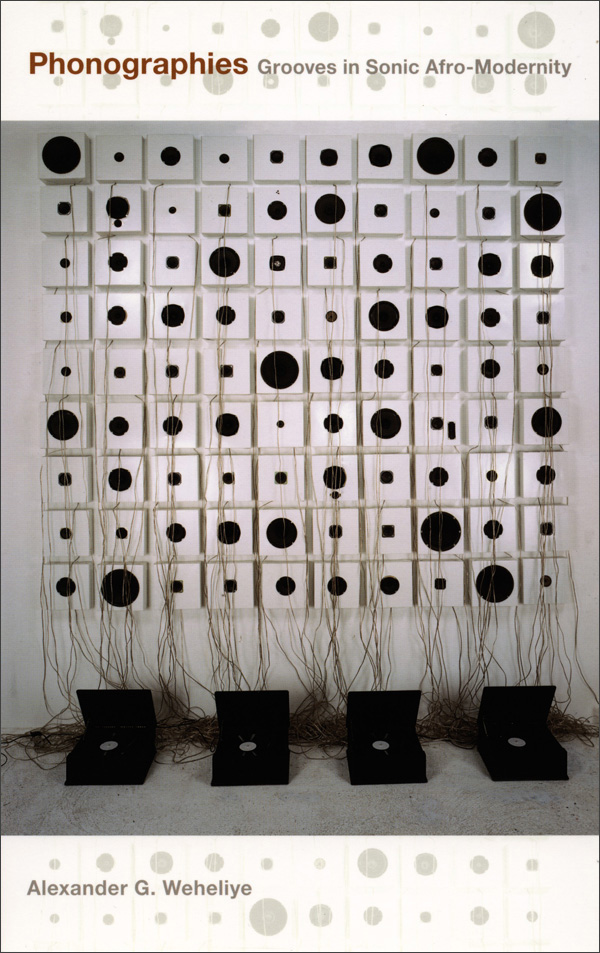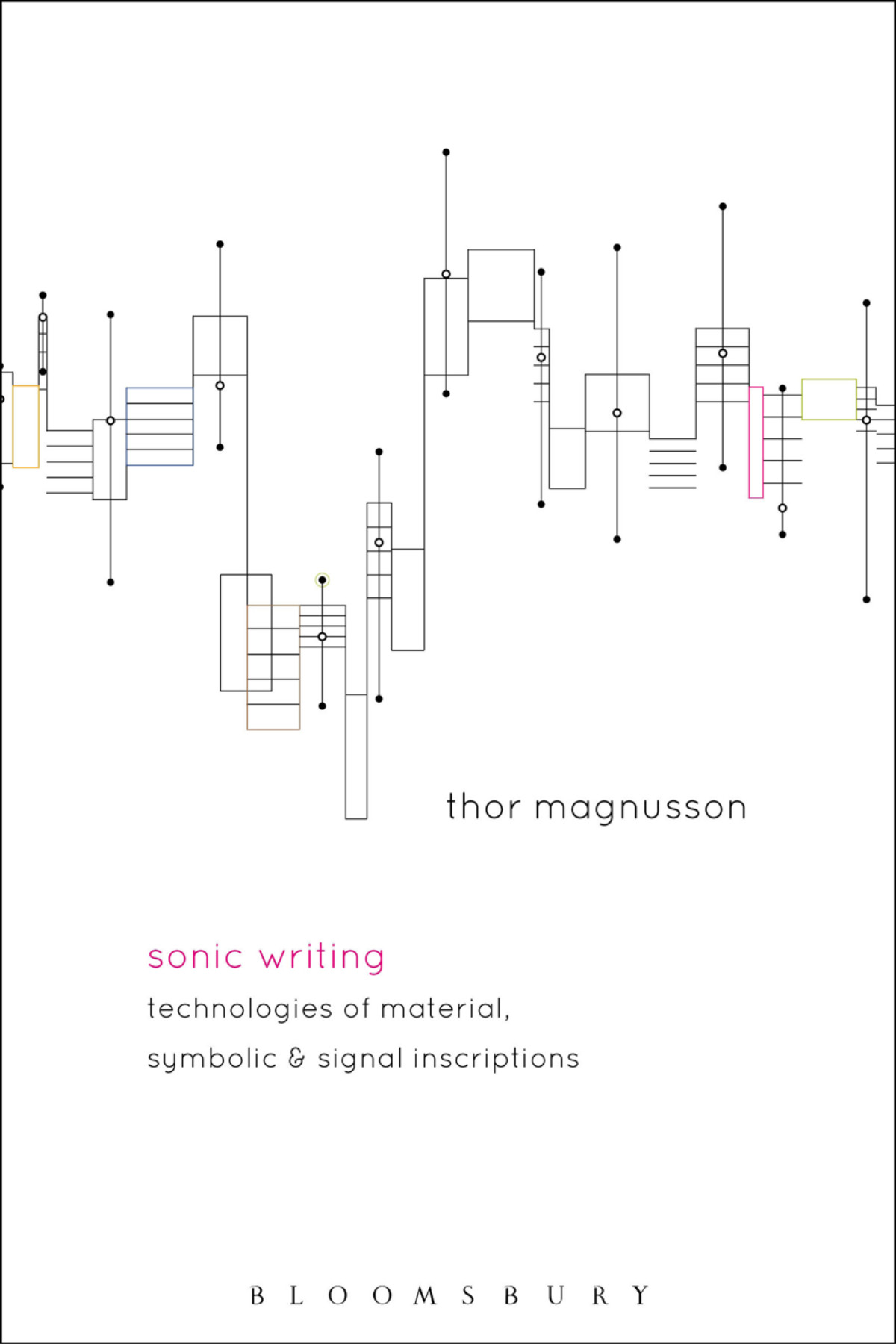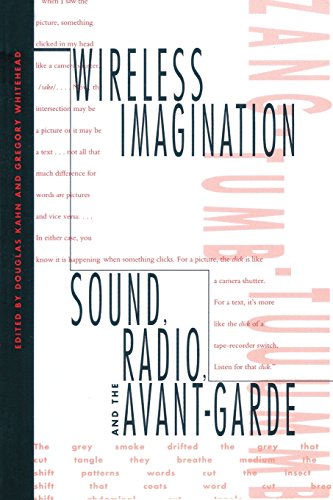Alexander G. Weheliye: Phonographies: Grooves in Sonic Afro-Modernity (2005)
Filed under book | Tags: · black people, djs, hip hop, modernity, music, music history, phonograph, sound, sound recording, technology

“Phonographies explores the numerous links and relays between twentieth-century black cultural production and sound technologies from the phonograph to the Walkman. Highlighting how black authors, filmmakers, and musicians have actively engaged with recorded sound in their work, Alexander G. Weheliye contends that the interplay between sound technologies and black music and speech enabled the emergence of modern black culture, of what he terms ‘sonic Afro-modernity’. He shows that by separating music and speech from their human sources, sound-recording technologies beginning with the phonograph generated new modes of thinking, being, and becoming. Black artists used these new possibilities to revamp key notions of modernity—among these, ideas of subjectivity, temporality, and community. Phonographies is a powerful argument that sound technologies are integral to black culture, which is, in turn, fundamental to Western modernity.
Weheliye surveys literature, film, and music to focus on engagements with recorded sound. He offers substantial new readings of canonical texts by W. E. B. Du Bois and Ralph Ellison, establishing dialogues between these writers and popular music and film ranging from Louis Armstrong’s voice to DJ mixing techniques to Darnell Martin’s 1994 movie I Like It Like That. Looking at how questions of diasporic belonging are articulated in contemporary black musical practices, Weheliye analyzes three contemporary Afro-diasporic musical acts: the Haitian and African American rap group the Fugees, the Afro- and Italian-German rap collective Advanced Chemistry, and black British artist Tricky and his partner Martina. Phonographies imagines the African diaspora as a virtual sounding space, one that is marked, in the twentieth century and twenty-first, by the circulation of culture via technological reproductions—records and tapes, dubbing and mixing, and more.”
Publisher Duke University Press, Durham, NC, 2005
ISBN 0822335778, 9780822335771
xii+286 pages
Reviews: Matthew Somoroff (NewBlackMan, 2006), Greg Tate (Souls, 2007), Emma Louise Kilkelly (Journal of American Studies, 2007), George Lipsitz (Journal of the Society for American Music, 2008).
Commentary: Alexander G. Weheliye (Small Axe, 2014), Tavia Nyong’o (Small Axe, 2014).
PDF (updated on 2021-4-13)
Comment (0)Thor Magnusson: Sonic Writing: Technologies of Material, Symbolic, and Signal Inscriptions (2019)
Filed under book | Tags: · artificial intelligence, computer music, machine learning, media, media technology, media theory, music, musical instruments, notation, phonograph, sound, sound recording, writing

“Sonic Writing explores how contemporary music technologies trace their ancestry to previous forms of instruments and media. Studying the domains of instrument design, musical notation, and sound recording under the rubrics of material, symbolic, and signal inscriptions of sound, the book describes how these historical techniques of sonic writing are implemented in new digital music technologies. With a scope ranging from ancient Greek music theory, medieval notation, early modern scientific instrumentation to contemporary multimedia and artificial intelligence, it provides a theoretical grounding for further study and development of technologies of musical expression. The book draws a bespoke affinity and similarity between current musical practices and those from before the advent of notation and recording, stressing the importance of instrument design in the study of new music and projecting how new computational technologies, including machine learning, will transform our musical practices.
Sonic Writing offers a richly illustrated study of contemporary musical media, where interactivity, artificial intelligence, and networked devices disclose new possibilities for musical expression. Thor Magnusson provides a conceptual framework for the creation and analysis of this new musical work, arguing that contemporary sonic writing becomes a new form of material and symbolic design–one that is bound to be ephemeral, a system of fluid objects where technologies are continually redesigned in a fast cycle of innovation.”
Publisher Bloomsbury Academic, New York & London, 2019
ISBN 9781501313851, 1501313851
xiv+290 pages
Reviews: Gregory Taylor (Cycling ’74, 2019), Diana Chester (Interference, 2019).
Author’s research blog
Publisher
WorldCat
Douglas Kahn, Gregory Whitehead (eds.): Wireless Imagination: Sound, Radio, and the Avant-Garde (1992)
Filed under book | Tags: · art history, audio art, avant-garde, dada, futurism, music, music history, phonograph, radio, radio art, sound, sound art, surrealism

“Wireless Imagination addresses perhaps the most conspicuous silence in contemporary theory and art criticism, the silence that surrounds the polyphonous histories of audio art. Composed of both original essays and several newly translated documents, this book provides a close audition to some of the most telling and soundful moments in the ‘deaf century,’ conceived and performed by such artists as Raymond Roussel, Antonin Artaud, Marcel Duchamp, André Breton, John Cage, Hugo Ball, Kurt Weill, and William Burroughs.
From the late nineteenth century to the 1960s, the essays uncover the fantastic acoustic scenarios projected through the writings of Raymond Roussel; the aural objects of Marcel Duchamp; Dziga Vertov’s proposal for a phonographic ‘laboratory of hearing’; the ZAUM language and Radio Sorcery conjured by Velimir Khlebnikov; the iconoclastic castaways of F.T. Marinetti’s La Radia; the destroyed musics of the Surrealists; the noise bands of Russolo, Foregger, Varèse, and Cage; the contorted radio talk show delivered by Antonin Artaud; the labyrinthine inner journeys invoked by German Hörspiel; and the razor contamination and cut-up ventriloquism of William S. Burroughs.”
With essays by Douglas Kahn, Charles Grivel, Craig Adcock, Christopher Schiff, Mel Gordon, Gregory Whitehead, Allen S. Weiss, Mark E. Cory, Frances Dyson, and Robin Lydenberg.
Publisher MIT Press, 1992
ISBN 0262111683, 9780262111683
xi+452 pages
Reviews: Timothy Dean Taylor (Postmodern Cult, 1993), David L. Austin (Art Doc, 1993), Gerald Hartnett (Leonardo Music J, 1994), Stephen Miles (Notes, 1994), Ágnes Ivacs (Artpool, n.d.).
PDF (98 MB, no OCR)
Comment (0)
